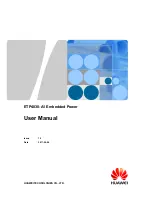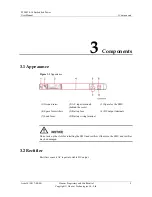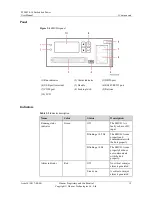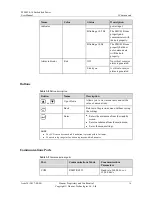
ETP4830-A1 Embedded Power
User Manual
1 Safety Precautions
Issue 10 (2017-08-08)
Huawei Proprietary and Confidential
Copyright © Huawei Technologies Co., Ltd.
4
High short circuit currents or electric shocks can cause equipment damage, personal injury, or
death.
To prevent short circuit or electric shock, disconnect the batteries before performing any
operation or maintenance.
Flammable Gas
Do not use unsealed lead-acid batteries.
Lead-acid batteries emit flammable gas. Therefore, place and secure lead-acid batteries
horizontally to prevent fire or corrosion.
Store lead-acid batteries in a place with good ventilation, and take fire safety precautions.
Battery Leakage
High temperatures may result in battery distortion, damage, and electrolyte overflow.
If the battery temperature is higher than 60°C, battery electrolyte may overflow. If the
electrolyte overflows, wear goggles, rubber gloves, and protective clothing and absorb the
leaking electrolyte using sodium bicarbonate (NaHCO
3
) or sodium carbonate (Na
2
CO
3
). Do
not transport or move batteries if there is an electrolyte leakage.
Battery Overdischarge
After connecting the batteries, remove the battery fuse or turn the battery circuit breaker OFF
and then power on the power system. This prevents battery overdischarge. After the power
system is on, replace the battery fuse or turn the battery circuit breaker ON.
1.4 Cable Layout
When routing cables, ensure that a sufficient distance exists between the cables and the
DC busbar, shunt, and fuse. This prevents damage to the insulation layer of the cables.
Route and bind signal cables and power cables separately.
Ensure that cables meet the VW-1 testing requirements.
Do not route cables behind the air exhaust vents of rectifiers in the cabinet.
Ensure that all cables are securely bound.



























